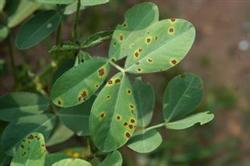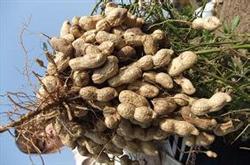Measures of "three Prevention" to promote yield increase in the later stage of Peanut

Production practice has proved that in the middle and later stages of peanut growth, timely "three prevention", that is, prevention of overgrowth, premature senility and disease and insect pests, can increase production by 20% and 30%. (1) Peanut fields with good water and fertilizer conditions and vigorous growth of dwarf plants can be sprayed with plant growth regulators when a large number of peanut fruit needles enter the soil. 15% paclobutrazol powder was sprayed on 40-50Kg / mu or 20% 30ml / mu / mu 40Kg. Should be sprayed in the afternoon to avoid re-spray, leakage spray, spray within 8 hours in case of rain to re-spray. (2) for peanuts with insufficient basal fertilizer or high yield, spraying foliar fertilizer in the middle and later stage of peanut growth is an effective measure to obtain high quality and high yield of peanut. The mixture of 1% urea and 0.5% potassium dihydrogen phosphate can be sprayed 50 days before harvest, 50 Kg per mu. Spraying every 10 days, generally spraying 2 Mel for 3 times, played a significant role in improving the photosynthetic capacity of leaves and promoting the fullness of pods. (3) Disease and pest control due to more rainfall and high humidity in the middle and later stages of peanut growth, it is easy to lead to the occurrence of leaf spot disease, and the yield of peanuts is generally reduced by 20% and 30%. 50% carbendazim 1000 times solution, 70% mancozeb 500 Mel 600 times solution or 70% methyl topiramate 1500 times solution can be used for prevention and control, spraying every 7 days for 2 times continuously for 3 times. The main pests in the later stage of peanut are grub and cotton bollworm. From late July to early August, 0.5 Kg of amidophos or phoxim were used to control grubs. To control Helicoverpa armigera, the harm of cotton bollworm was found from early July to early August. 1500 times liquid of Kuaishaling can be sprayed in the evening or morning, and mixed with fungicides.
- Prev

What is the expression of peanut calcium deficiency? How to prevent?
Symptoms of iron deficiency peanut performance for the upper part of the tender leaves chlorosis, while the lower part of the old leaves and veins remain green; severe iron deficiency, veins chlorosis and yellowing, the upper part of the new leaves all white, brown spots necrosis, dry and fall off. Control methods can choose 0.1%~0.2% ferrous sulfate solution foliar spray...
- Next

Key Techniques for High-yielding Cultivation of Peanut
China's peanut planting area is about 70 million mu, accounting for 1/3 of the country's oil production area, the total output of 48% of the country's total oil production, ranking first among oil crops. Peanut farming methods With the continuous innovation of cultivation techniques and the selection and promotion of early-maturing varieties, peanut farming systems are also ripe from one year to one year.
Related
- The first cup of black tea in spring, the flavor and history of tea gardens in Kenya, Africa
- The computer can not only choose potatoes, but also grow tea rice. AI will grow winter oolong tea champion.
- It is not only the inflated tea bitten by insects, but also engraved with the four seasons tea in Beipu.
- The Oriental Beauty Tea Festival in Zhuxian County takes the stage at the weekend to experience the plus-size feast of oil tea.
- & quot; Oriental Beauty Tea & Exploration of Emei in Hsinchu, the hometown of quot;
- The new variety of strawberry "Tainong 1" dessert is the first choice with mellow aroma. Crimson gorgeous
- History of Tea in Taiwan: from Wild Inner Mountain to Export Tea Garden
- Two types of Taiwan Oriental Beauty Black Tea won the British three-Star Award for Childhood Tea Xiang Zhang Jiaqi changed from pilot to champion tea maker.
- Banana species and varieties: the planting history of Taiwan Xianren banana and dwarf banana is long, is banana disease resistant?
- Coffee planting Technology: Qianjie Coffee from Seedling to harvesting

